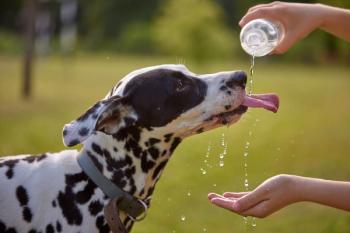
Exploring physical therapy modalities in veterinary rehabilitation
Dogs are now routinely reaping the benefits from many physical modalities formerly used only to treat people.
For centuries, physical therapy has been used to help treat disease, injury, chronic pain, or disability in people. In recent years, however, this trend has caught on in canine rehabilitation, as dogs are now routinely reaping the benefits from the many physical modalities formerly used only to treat their owners.
Some of these therapeutic treatment methods include electrotherapy, electromagnetic fields, light therapy, hot and cold therapies, and ultrasonography. Although all of these modalities can improve outcomes for your patients, using them alone will not guarantee improvement. For best results, proper training is essential. In fact, certified rehabilitation professionals must complete many hours of coursework and hands-on learning to fine-tune their diagnostic techniques and manual skills needed to apply these physical modalities correctly. Let's take a look at each course of treatment more closely in order to better understand the bottom-line benefits for canines.
Electrotherapy
Electrotherapy can be used for wound healing, pain control or relief, reduction of inflammation, muscle re-education, reversal of atrophy and strengthening. This modality works at many levels, affecting both the sensory and motor nerves. At the cellular level, electrotherapy causes nerve cell excitation and changes in cell membrane permeability, therefore stimulating protein synthesis, osteosynthesis and fibroblast formation. At the tissue level, electrotherapy causes skeletal muscle and smooth muscle contraction. At the segmental level, it facilitates muscle-pumping action, resulting in improved joint mobility as well as circulatory and lymphatic drainage.
An application of electrical current through the skin, transcutaneous electrical nerve stimulation (TENS) is used primarily to manage pain. A small, battery-operated TENS unit delivers an electrical current to the patient through electrodes placed directly on the skin. The pulse rate, width and intensity can be adjusted according to treatment objectives. TENS works by stimulating faster sensory nerves with an electrical impulse, causing an overload of interneurons, which limits the ability of sensory nerves to transmit pain signals to the brain, creating analgesia for the patient. The effect of this modality is short-lived, however, as it generally does not last for more than an hour. In veterinary rehabilitation, TENS is used immediately post-operatively and during therapy to help a patient work through a painful treatment.
Stimulating the nerve that causes the muscles to contract, neuromuscular electrical stimulation (NMES) is used to rehabilitate muscles. This method is delivered to the patient via leads and flexible, low-resistance electrodes that conform to the skin. NMES can be used to help prevent muscle atrophy, increase local blood circulation, and maintain or increase joint mobility. It is particularly useful in patients with edema, delayed wound healing, or in those unable to perform voluntary movement.
The NMES unit features many adjustable variables, including intensity, pulse duration, current, frequency, on-off times, ramp duration and treatment duration. Ramp duration — the amount of time from the onset of the current until the full strength is delivered — is particularly important in veterinary rehabilitation. In human physical therapy, the therapist can explain to the patient how the current and contraction will feel. We don't have this luxury with our patients; therefore, we must provide a slow, gradual onset of contraction strength to alleviate as much discomfort as possible. An NMES treatment generally lasts 15 to 20 minutes and achieves best results when used two to three times a week.
Contraindications for electrotherapy include treatment over areas of electrical current, such as pacemakers, the carotid sinus, the cervical ganglia and the heart. This modality should be avoided (or at least used with caution) in pregnant patients or in those with a malignancy.
PEMF therapy
Pulsed electromagnetic field (PEMF) therapy is used to speed healing and relieve pain. Exposure to this combination of electric and magnetic fields can promote ion transport across cell membranes, improving cell metabolism and healing. Used since the 1970s in human medicine to treat delayed union fractures, PEMF is used in veterinary rehabilitation for pain management in orthopedic injuries and in chronic conditions, including hip dysplasia. Many products on the market today deliver PEMF therapy to canine patients, the most popular of which are jackets and beds or pads. All are battery-operated with timers that allow for a standard 20- to 30-minute treatment session.
Light therapy
Laser treatment is used for pain management, inflammation control and tissue healing. The physiological effects include accelerated cell division via mitochondrial stimulation, increased leukocyte phagocytosis, stimulation of fibroblast production, enhanced synthesis of ATP and angiogenesis. Lasers are divided into four classes based on their power.
Most therapeutic or "cold" lasers are in Class 3 with power ranging from 1 milliwatt to 500 milliwatts. "Hot" lasers, which are commonly used in surgery, fall into Class 4 with more than 500 milliwatts of power. Laser therapy is measured in joules (the energy delivered by 1 watt of laser energy in 1 second). Most therapeutic regimens call for 1 to 8 joules of energy. The penetration depth is determined by the laser's wavelength. Higher power simply delivers this energy to the same depth at a faster rate.
Hot and cold therapies
Thermotherapy is generally used to reduce pain from arthritis and muscle spasms, and to prepare tissues for exercise or stretching. Heat can be applied by hot packs, infrared light, hydrotherapy and therapeutic ultrasonography. Thermotherapy can result in vasodilation with secondary increased local circulation, a decrease in pain, relaxed muscle tone, reduced muscle spasm, and an increase in tissue extensibility, cellular metabolism and local tissue oxygenation. It should not be used in patients with impaired thermal sensation, recent hemorrhage, malignancy or acute inflammation.
Applied via ice bath/massage/pack, vapocoolant gel or circulating ice compression units, cryotherapy is commonly used in the acute period after injury or surgery. The benefits include vasoconstriction, reduced cellular metabolism, decreased nerve conduction velocity (leading to analgesia), reduction of edema and decreased muscle spasm. Use caution when applying cold therapy to patients with decreased sensation, cold hypersensitivity, or the potential for reflex vasodilation (the "Hunting Reflex"), a profound vasodilation caused by extended exposure to cold.
Therapeutic ultrasonography
This modality involves the application of sound waves directly to the skin to produce a vibration in the underlying tissue. The intensity can be adjusted from 1 MHz to 3 MHz, depending on the desired effects, which could include deep local heating, an increase in blood flow and breakdown of scar tissue. This modality can be used in veterinary rehabilitation to treat a number of conditions, including joint swelling, muscle spasms, strain lesions and biciptial tenosynovitis.
Similar to diagnostic ultrasonography, therapeutic ultrasonography converts electricity to sound waves by a piezoelectric effect in the transducer head. Ultrasound waves are attenuated by the tissues they pass through. Bone attenuates the waves the most, followed by cartilage, tendon, skin, blood vessel, muscle, fat and, finally, blood. This variation must be taken into account when determining the treatment intensity for a tissue or lesion that sits deep in any of these tissues. There are many variables that can be applied to therapeutic ultrasonography, including duty cycle, frequency, intensity and treatment duration. Generally, treatment time will equal about five minutes for a space that is twice the size of the transducer head.
Making use of modalities
There are many physical modalities available to veterinary rehabilitation therapists that can add tremendous benefit to patients. However, it's important to remember that purchasing the best equipment does not necessarily guarantee great results. When used together, meticulous diagnostic techniques, excellent manual techniques and creative problem-solving skills make all the difference.
Dr. Van Dyke is the founder and CEO of the Canine Rehabilitation Institute in Wellington, Fla., with locations in Fort Collins, Colo., and Annapolis Junction, Md.
Newsletter
From exam room tips to practice management insights, get trusted veterinary news delivered straight to your inbox—subscribe to dvm360.






